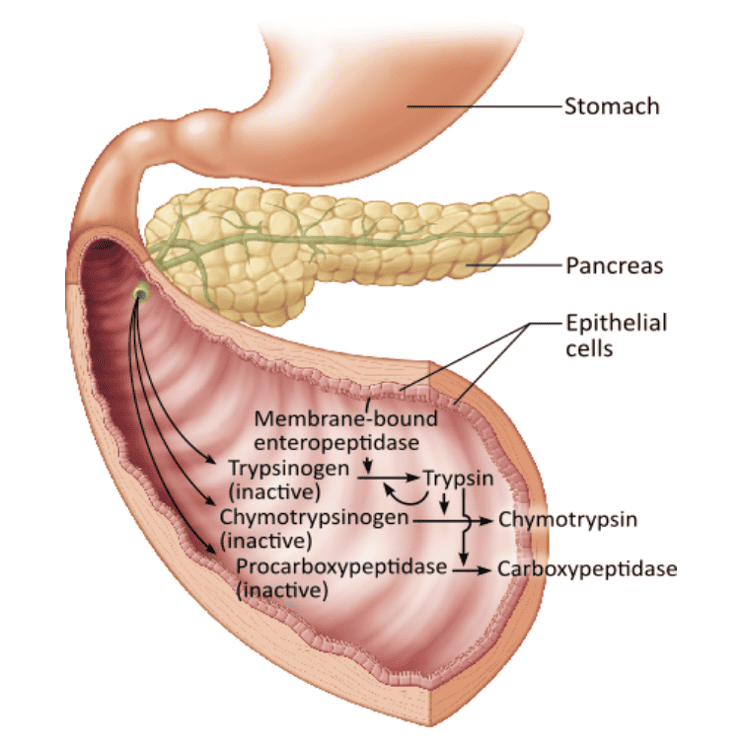Carbohydrates are digested into __________.
- nucleotides
- monosaccharides
- amino acids
- glycerol
monosaccharides
Ex.
Monosaccharides are simple sugars, the building blocks of complex carbohydrates such as starch or glycogen.
Which of the following functions is NOT correctly matched with its description?
- mechanical breakdown: churning movements in the GI tract
- ingestion: taking food into the digestive tract
- propulsion: physical breakdown of ingested food in the GI tract
- absorption: transport of chemically digested nutrients into the blood or lymph
propulsion: physical breakdown of ingested food in the GI tract
Ex.
Propulsion is the movement of ingested food through the GI tract.
The mechanical and chemical receptors that control digestive activity are located ________.
- in the glandular tissue that surround the organ lumen
- in the pons and medulla
- in the oral cavity
- in the walls of the tract organs
in the walls of the tract organs
Bile salts break up the fat globule into smaller fat droplets. This role of bile salts is best described as ________.
- lipid digestion
- lipid emulsification
- lipid absorption
- lipid ingestion
lipid emulsification
The __________ phase of gastric secretion begins as chyme enters the duodenum.
gastric phase
reflux
intestinal
cephalic
intestinal
Ex.
The intestinal phase of gastric secretion is set into motion as partially digested food fills the first part (duodenum) of the small intestine.
The ingestion of a meal high in fat content would cause which of the following to occur?
- The acid secretions from the stomach would be sufficient to digest this food but may cause heartburn.
- This type of food would cause secretion of gastrin to cease, resulting in faster gastric emptying.
- Bile would be released from the gallbladder to emulsify the fat in the duodenum.
- Increased production of trypsinogen.
Bile would be released from the gallbladder to emulsify the fat in the duodenum.
Some antacid drugs block histamine receptors, resulting in reduction of the production and excretion of stomach acid. These drugs have the biggest effect on which of the following?
- chief cells
- parietal cells
- surface epithelial cells
- mucous neck cells
parietal cells
Bacteria that reside in the large intestine make vitamin C.
- True
- False
False
Ex.
Bacteria that reside in the large intestine make B complex vitamins and vitamin K. Enteric bacteria also form gases such as CO2, methane, H2, and N2 as byproducts of metabolizing nondigested starches such as cellulose.
When we ingest large molecules such as lipids, carbohydrates, and proteins, they must undergo catabolic reactions whereby enzymes split these molecules. This series of reactions is called ________.
- secretion
- digestion
- mechanical breakdown
- absorption
digestion
Bile is secreted by the __________ under hormonal influence of __________.
- pancreas; secretin
- gallbladder; gastrin
- small intestine; CCK
- liver; secretin
liver; secretin
Ex.
Secretion of bile from the liver is stimulated hormonally by secretin. Bile salts themselves provide the major stimulus for enhanced bile secretion. After a fatty meal, when the enterohepatic circulation is returning large amounts of bile salts to the liver, its output of bile rises dramatically.
Choose the incorrect statement regarding bile.
- Bile functions to carry bilirubin formed from breakdown of worn-out RBCs.
- Bile contains enzymes for digestion.
- Bile is both an excretory product and a digestive secretion.
- Bile functions to emulsify fats.
Bile contains enzymes for digestion.

What is a major function of pancreatic juice?
- acidifying the contents of the small intestine
- emulsifying fats by breaking them into smaller pieces
- neutralizing chyme entering the small intestine from the stomach
- secreting hormones that help digest food in the duodenum
neutralizing chyme entering the small intestine from the stomach
Ex.
Pancreatic juice contains bicarbonate (as baking soda does) that can neutralize the pH of acidic chyme coming from the stomach.
Which of the following are NOT correctly matched?
- amylase: carbohydrate digestion
- protease: lipid digestion
- nuclease: DNA and RNA digestion
- lipase: fat digestion
protease: lipid digestion
Ex.
Proteases digest proteins.
Short-chain triglycerides found in foods such as butterfat molecules in milk are split by a specific enzyme in preparation for absorption. Which of the following enzymes is responsible?
- pepsin
- amylase
- lipase
- chymotrypsin
lipase